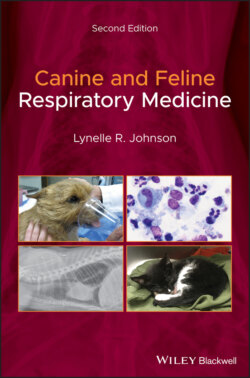Читать книгу Canine and Feline Respiratory Medicine - Lynelle Johnson R., Lynelle R. Johnson - Страница 38
Diagnostic Imaging Radiography
ОглавлениеRadiography is often the key to creating an appropriate list of differential diagnoses for the respiratory case and for determining the type of sampling method that is most likely to achieve a final diagnosis, such as endoscopy, fine‐needle aspiration (FNA), or a tracheal wash (Table 2.3). It will also help determine the need for advanced imaging, including fluoroscopy, ultrasound, nuclear scintigraphy, or computed tomography (CT). The widespread use of digital radiography has enhanced the evaluation of pulmonary patterns, although overlying structures can still confuse interpretation. Specific features of these tests are presented in the relevant disease sections.
Table 2.2 Respiratory causes of hypoxemia.
| Mechanism | Clinical attributes | Causes |
| Hypoventilation | High PaCO2 Normal A–a gradient Improved by oxygen supplementation Improved by increasing alveolar ventilation | Anesthesia Upper airway obstruction Neuromuscular weakness CNS disease |
| V/Q mismatch | Increased A–a gradient Mildly increased PaCO2 Markedly improved by oxygen supplementation | Virtually any lung disease |
| Shunt | Increased A–a gradient Not improved by oxygen supplementation Not improved by increasing alveolar ventilation | Congenital right to left cardiac shunts Acute respiratory distress syndrome |
| Diffusion impairment | Increased A–a gradient Seldom a major cause of hypoxemia at rest Causes hypoxemia during exercise or with low inspired oxygen Improved by oxygen supplementation | Interstitial lung disease Pulmonary edema |
| Reduced inspired oxygen | Improved by oxygen supplementation Causes hypoxemia during exercise or when diffusion is impaired | High altitude |
A–a, alveolar–arterial; CNS, central nervous system; PaO2, partial pressure of oxygen.
Table 2.3 Airway sampling techniques for various lung patterns.
| Radiographic pattern | Differential diagnoses | Sampling technique |
| Interstitial | Viral pneumonia Rickettsial pneumonia Protozoal pneumonia Hemorrhage Vasculitis Pulmonary fibrosis Neoplasia Early pulmonary edema Aspiration pneumonia | Fine‐needle aspirate Lung biopsy Bronchoscopy Tracheal wash |
| Bronchial | Chronic bronchitis Feline bronchitis/asthma Bronchiectasis Parasitic bronchitis Early bronchopneumonia | Tracheal wash Bronchoscopy |
| Alveolar | Bronchopneumonia Aspiration pneumonia Fungal pneumonia Hemorrhage Pulmonary edema Neoplasia Non‐cardiogenic pulmonary edema | Tracheal wash Bronchoscopy |
| Consolidation | Neoplasia Lung lobe torsion Consolidating pneumonia Granuloma Bronchial obstruction Feline bronchitis Foreign body inhalation | Bronchoscopy Fine‐needle aspirate Tracheal wash |
| Vascular | Congenital heart disease Congestive heart failure Heartworm disease Pulmonary hypertension Pulmonary thromboembolism | Echocardiography |
| Effusion | Hydrothorax Pyothorax Hemothorax Chylothorax Neoplasia Diaphragmatic hernia | Thoracocentesis |
Orthogonal views are always recommended for evaluation of thoracic contents, and assessment of the thorax is improved by obtaining both left and right lateral views, as well as a dorsoventral or ventrodorsal image. Lateral views provide an optimized view of the lung closest to the radiographic unit, therefore a left lateral projection would be more likely to identify infiltrates in the right middle lung lobe in a patient with aspiration pneumonia. A right lateral projection might be preferred to investigate airway collapse at the left cranial lobar bronchus (cranial and caudal segments). The dorsoventral view provides better imaging of the cardiac silhouette and pulmonary vessels, although the ventrodorsal view allows better assessment of small volumes of pleural effusion, as well as infiltrates in the ventral or lateral portions of the lung. Importantly, attempts should be made to confirm the presence of pulmonary nodules on both a lateral and an orthogonal view.
In some patients, cervical radiographs can provide valuable information on the extrathoracic respiratory tract and its potential role in thoracic disease. Loss of the nasal air column from the nasal cavity into the nasopharynx, elongation or thickening of the soft palate, the suggestion of laryngeal edema or mass, air in the laryngeal saccules, or caudal retraction of the larynx are clues to the presence of an upper airway obstructive lesion that could be contributing to disordered breathing or a lower respiratory tract process.
